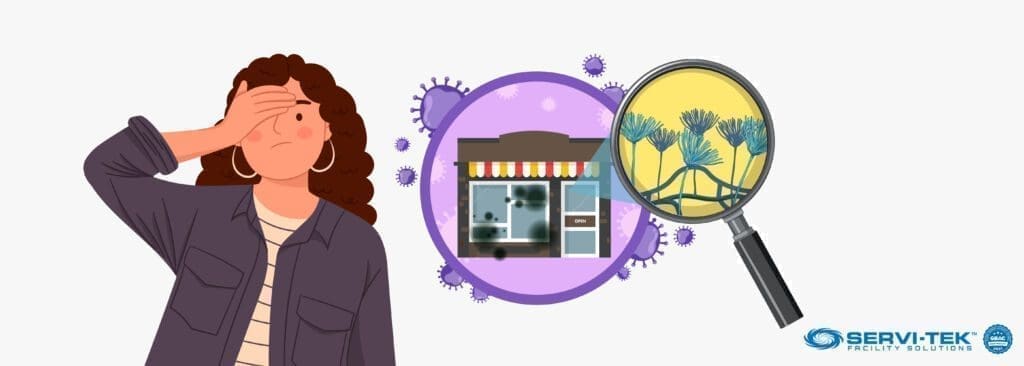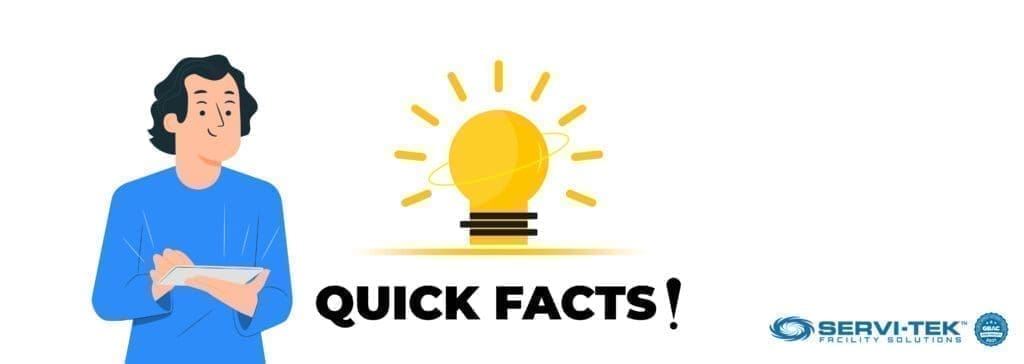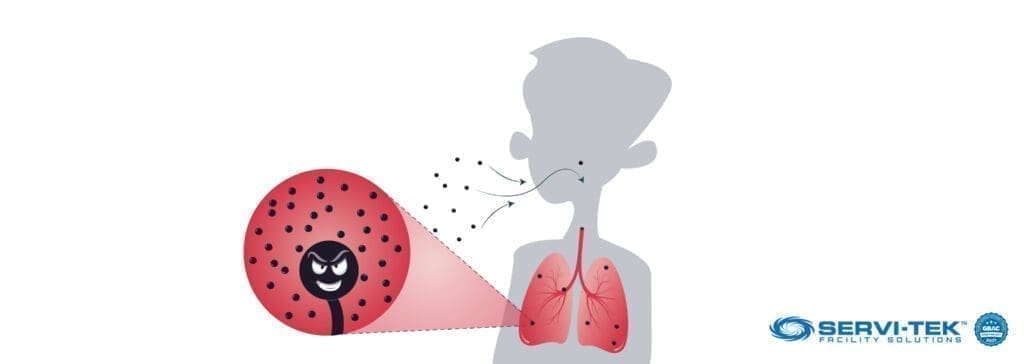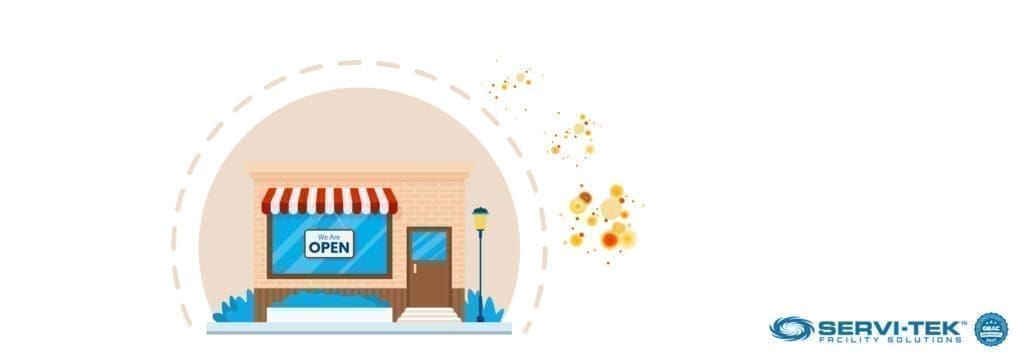
The retail industry is not in a very good place right now. With eCommerce leaching away its customers and struck hard by the double whammy of pandemic restrictions and high inflation, bricks and mortar locations have their plates full, as far as survival threats are concerned.
If you own a retail business, the last thing your stores need right now is a mold outbreak. It may not be a burning priority right now, but we will explain why you cannot afford to have these pesky fungi mess with your business.
Read on to find everything you need to know about the health hazards posed by mold growth in your building, both to your staff, customers, and potentially even your bottom line. We will start with a quick intro to mold.
Basic Facts About Mold

Mold is a type of fungal growth that appears on damp, decaying organic matter. Many different species of fungi can create mold in a wide range of different colors. These organisms play a vital role in nature, decomposing dead organic matter to create nutrition for other living things.
In the outdoors, mold can be easily found on dead wood, fallen leaves, and even dead bodies in an advanced stage of decomposition. They can grow anywhere as long as there is adequate moisture, warmth, and a source of carbon (from organic compounds)
Apart from their benefits to nature, mold is also proven to be useful for humans. Penicillin was developed from a mold belonging to the Penicillium genus. The same species of fungi are also used to make cheese.
Where Does Mold Grow Indoors?

While they are abundant in the wild, many types of mold can just as easily survive and flourish indoors, in our homes, offices, and public buildings. Mold is attracted to areas that have the following features:
- Abundant moisture/dampness
- Warm temperatures, anywhere between 40F to 100F
- Shade and protection from direct sunlight
- Poor ventilation
- A supply of organic nutrients
When we say nutrients, we don’t mean just edible food. Fungi can survive on anything – wood, dead plant matter, decaying fruits/vegetables, and even specks of organic waste found in dust. As long as it has a carbon-based organic molecule to digest, mold can survive.
Indoor mold growth is most common in locations that have high levels of exposure to moisture. In a retail store, this can include locations like:
- Storage areas
- Basements
- HVAC systems
- Any walls/ceilings adjacent to the plumbing
- Bathrooms
- Near refrigeration units
As you can see, a mold infestation inside a retail store has the potential to expose both your employees and customers to fungi.
Is Mold Dangerous To Health?

Unlike viruses or bacteria, which are clear threats to human health, fungi are not as dangerous. They do not aggressively infect us and cause disease. But if you allow mold to grow unchecked in indoor spaces, it can lead to moderate to severe health issues.
Mold exposure happens when you accidentally inhale mold particles in the air, or when you ingest food items that have been contaminated with mold. Inhalation is the most common way in which people get exposed to many types of mold.
Mold Allergies
Mold is primarily made up of a network of long filaments, called hyphae. The tangled network of hyphae resembles a lawn filled with grass and is called the mycelium. On top of these filaments, mold will eventually develop spores that help the fungi spread and reproduce.
These fungal spores travel in the air and can cause mold allergies in many individuals. Children, seniors with COPD, and other adults with allergies are more vulnerable to side effects from mold spores.
Breathing mold spores can lead to runny nose, nasal congestion, severe bouts of sneezing, coughing, headaches, wheezing, and in severe cases, fever and secondary lung infections by bacteria that often accompany the mold.
Mold Poisoning
A lesser, but more lethal threat from mold exposure is from toxic chemicals. Some species of mold, like S. chartarum, can secrete toxins called trichothecene mycotoxins. The infamous “black toxic mold” is considered dangerous because of the risk of mold toxicity from mycotoxins.
Exposure to mold mycotoxin can result in the following symptoms and complications:
- On Skin – rashes, blisters, and burning pain
- On Eyes – blurred vision and irritation, redness
- On Inhalation/ingestion – cough, weakness, hypotension, allergies, neurotoxicity, possible organ damage, digestive issues
The impact of mycotoxin impact on human health is not clearly understood. More studies are needed to show a direct correlation between exposure to mold and severe health issues like neurotoxicity, organ damage, and death.
Who Is At Risk Of Adverse Health Effects From Mold?

In otherwise healthy adults, short-term mold exposure should not cause any major complications. In relation to this, it can be dangerous for individuals with weak immune systems – AIDS patients, cancer patients undergoing chemotherapy, and organ transplant patients should all be extra careful when around the mold.
Children and adults suffering from respiratory issues like asthma and allergies are also more likely to have sudden reactions to mold exposure. Last but not least, seniors are more vulnerable to mold than any other age group, since they tend to have a greatly weakened immune system.
Dangers Of Mold To A Retail Store

The uncontrolled growth of mold in your retail store premise can affect your business in several different ways. It can cause health problems in your employees, impact your brand reputation among customers, and bring a host of other complications. In this section, we will explore all aspects of mold damage to your business:
Are There Any Federal/State Regulations On Mold?
As a retail business owner, you have a legal obligation to provide a safe workplace for your employees and maintain adequate hygiene and air quality for the benefit of your customers (the general public). There are numerous local municipal codes, state regulations, and federal guidelines on this subject.
Based on this, there are no regulations directly related to mold in these statutes, since the correlation between mold and severe health effects is still not medically proven. But since mold allergy is well-recognized, agencies like the OSHA and Center for Disease Control (CDC) do provide guidelines and suggestions to employers on mold control.
As an interesting aside, you are more likely to encounter a mold outbreak in your store if you don’t adequately follow regulations related to HVAC maintenance, sanitation, and other municipal building codes.
So, even if you are not in violation of any codes by a mold infestation, the conditions that encouraged the growth (leaking pipes, dampness, poor maintenance, inadequate ventilation) may all put you at higher risk of penalties.
Mold Exposure Risk To Employees
Since they spend the maximum amount of time inside your store premises, your employees are at the greatest risk of health issues from mold exposure. If left untreated, extended exposure to mold spores and toxins may even contribute to respiratory problems and even lethal diseases like cancer.
Mold has a repulsive appearance and odor and can make the workplace depressing and unhygienic. It can lead to a drop in morale among your staff and contribute to higher levels of attrition. With employees leaving the retail industry in droves, this is the last thing you need right now.
Furthermore, a persistent mold infestation can also increase the risk of allergies, asthma, and other illnesses in your employees, leading to lower productivity, increased insurance costs, and even opening your business to the risk of lawsuits.
Mold Damage To Stock
It doesn’t matter if your store sells stationary, groceries, electronics, apparel, or packaged food and beverages. All these products can be damaged by fungal growth. The problem is particularly acute with food and groceries, as they come with stringent storage and hygiene regulations.
A wrong step here and you are looking at stiff penalties and lawsuits. Mold and mildew in dark storage areas and shelves can damage clothes, shoes, and other stock causing massive loss to your balance sheet.
Under the right conditions, fungi can achieve explosive growth rates, spreading far and wide within a matter of days. This is why you need to take immediate action if your employees report the presence of mold anywhere on your retail store premises.
Mold Impact On Customers
If you have even the slightest trace of visible mold in any customer-facing part of the store, it is a huge problem. And we are not talking about allergic reactions or other respiratory problems. Black mold can evoke a strong sense of panic in people, especially those who can remember its impact on the news cycle in the 1990s.
It can severely tarnish your reputation and make your store feel unappealing and unhygienic to customers. Retail customers are getting more demanding these days – they expect a high-quality experience when they enter any store, according to McKinsey.
Moldy walls and ceilings will turn them away from your business. This issue is further exacerbated by the COVID-19 pandemic. People are more nervous about the health risks posed by public spaces and stores. You need to create a safe, hygienic, and spotless store environment to impress your clientele.
Mold Impact On Your Buildings
Given enough time, the fungus can rot away your wooden fixtures and disintegrate drywall. In the long run, it will damage your building and can even affect the structural integrity in certain cases. This is why painting over a patch of mold is a bad idea – it can keep working its way inside your walls and ceilings.
The relationship between mold and concrete is a bit more complicated. Unlike wood, organic composites, and drywall, concrete does not provide mold any nutrients to grow. However, if you see mold flourish on concrete surfaces, it is a sign of deeper trouble, in the form of some kind of water leakage.
When you allow mold to gain control over structures that are still used by people, it can lead to a host of complications like lung disease, severe allergic reactions, skin rashes, and other serious health problems in inhabitants. With prolonged exposure, tenants often experience a condition called sick building syndrome.
And in the long term, moisture and water leaks can damage concrete. If you encounter significant blooms of different types of mold on your structures, your best option is to get it removed by the experts. Over time, you will end up paying a much higher cost if you ignore this.
How To Prevent Mold In Retail Stores

Mold is incredibly common in nature. There is no practical way to remove 100% of mold spores in your retail stores. However, the OSHA does provide helpful guidelines (NOT recommendations) on what levels are acceptable from an air quality perspective.
While you cannot prevent mold outbreaks, you can make them less likely with the following precautions:
Handle Leaks Quickly
Repair all leaks and plumbing issues within 24-48 hours whenever possible; if you let water damage and leaks persist beyond this timeframe, mold will form. Be on the alert for any potential signs of internal plumbing damage – wet spots on the walls/ceilings, drips, etc.
Control Internal Humidity
An indoor humidity level below 70% is necessary to discourage the growth of fungi. If possible, try to maintain a relative humidity level between 25% and 60% for the best results. Use air conditioning or dehumidifiers wherever appropriate to keep moisture levels under control.
Routine HVAC Maintenance
Moisture can often accumulate in air conditioner vents and ducts, allowing mold to thrive in an area that is out of sight and reach. This is dangerous as the spores can then spread to all corners of your facility. You will often sense a foul, musty smell from your AC when a mold problem develops in your HVAC vents.
Routine maintenance of all your HVAC systems as per vendor guidelines is vital. It can prevent moisture build-up and reduce the risk of mold proliferation inside your HVAC system. Always rely on certified experts when dealing with HVAC maintenance and troubleshooting for the best results.
Comply With Drainage Codes
Improper handling of drainage can lead to a heavy build-up of mold in building foundations, basements, etc. Always try to comply with local municipal codes on the subject. Provide adequate drainage systems around the building.
Call In Your Local Mold Experts To Keep Your Retail Stores Safe And Mold-Free!
With rising temperatures and increasing frequency of devastating weather events and floods, building owners will face additional challenges in mold control. While you can handle mold prevention on your own, removal is a whole different ball game.
Mold can penetrate deep inside your store’s walls, ceilings, and HVAC systems in a matter of days. If you detect the tell-tale signs of a mold infestation – musty smell, dark patches, stains, and so on – it is best to call in the cleaning experts at Servi-Tek.
To learn more, give us a call at (866) 454-6185, or schedule a call from us at a convenient time and date for you using the option on our contact us page.




